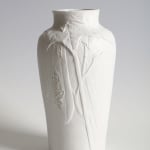-
Artworks
Shinkai Kanzan
Flower Vase with Sponge-Gourd Design, 1970PorcelainSize 13 x 7 x 7 in. (33.5 x 18 x 18 cm)T-4839Further images
-
(View a larger image of thumbnail 1
)

-
(View a larger image of thumbnail 2
)

-
(View a larger image of thumbnail 3
)

-
(View a larger image of thumbnail 4
)

-
(View a larger image of thumbnail 5
)

-
(View a larger image of thumbnail 6
)

-
(View a larger image of thumbnail 7
)

-
(View a larger image of thumbnail 8
)

-
(View a larger image of thumbnail 9
)

-
(View a larger image of thumbnail 10
)

-
(View a larger image of thumbnail 11
)

A vase of baluster form with rounded shoulder, short neck, and slightly out-turned mouth, modeled in high relief with a sponge-gourd (Luffa aegyptiaca) plant, the dried interior of the gourd...A vase of baluster form with rounded shoulder, short neck, and slightly out-turned mouth, modeled in high relief with a sponge-gourd (Luffa aegyptiaca) plant, the dried interior of the gourd rendered in great detail, signed on the base with characters drawn in the clay while it was still soft: Shōwa kanoe-inu tōjitsu Kibi Kanzan haji kinsaku (Respectfully made by the potter Kibi Kanzan in winter 1970)
Comes with the original paulownia-wood tomobako storage box inscribed: Hakujiyaki hechima hana-ike (Porcelain flower vase with sponge gourd) and Kashiko o kōei no kinzō mono Shōwa kanoe-inu Kibi Kanzan haji kinsaku (Carefully made as a mark of my respect, 1970, the potter Kibi Kanzan) and sealed Kibi
Born into a Kyoto ceramic family, Shinkai Kanzan studied under the leading porcelain specialists Seifū Yohei IV (his uncle) and Kiyomizu Rokubei VI; he started to participate in the Teiten national salon from 1930, exhibiting work there in a very wide range of techniques over the subsequent twenty-five years (interrupted by war service in China and imprisonment in Russia). In this striking work he describes himself as a member of the Haji, an early clan that specialized in pottery, and takes the name Kibi, referring to a ceramic ware made in Okayama Prefecture.
-
(View a larger image of thumbnail 1
)










